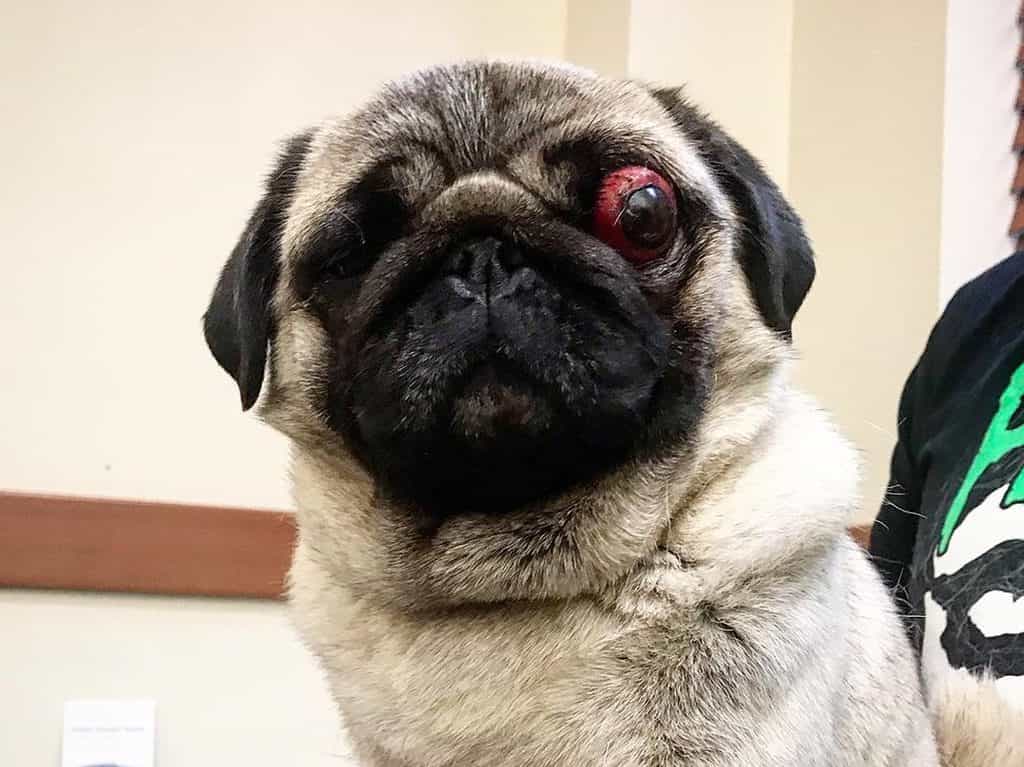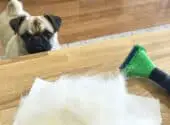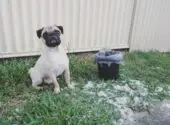Imagine: You open the door to your home after a long, exhausting day of work, only to be greeted by a Pug with one eye popping out of its head. It may seem like something out of a horror movie, but it can happen.
That’s right — Pugs can have their eyes pop out, and this medical emergency is called Proptosis.

What Exactly Is Proptosis?
Proptosis occurs when a dog’s eyeball has been displaced from its normal position in the socket. This can be caused by trauma, such as an accident, a fight with a large dog or even a blunt-force blow to the head.
This condition can sometimes lead to complications, including temporary nerve or orbital muscle damage, chronic tear film deficiencies, and vision loss.
But how can you tell if your dog has proptosis? Clinical signs of proptosis in dogs include redness or swelling around the eye area, squinting, dilated pupils, and bleeding inside the eye. Additionally, it could appear as if one side of your pup’s face looks bigger than normal due to the protruding eyeball.
Some dog owners often mistake bupthalmia for proptosis. Unlike proptosis, bupthalmia is a condition characterized by an abnormally large eyeball. Although it may seem counterintuitive, this does not mean that the eyeball has protruded; instead, it simply appears larger due to glaucoma or a tumor.
Now that you know the straightforward answer to the question can Pugs eyes pop out, let’s move on to the next:
Is Proptosis Common In Pugs?
Yes, proptosis is common in Pugs. This is because of their unique anatomy: shallow eye sockets and wide eyelids. Unfortunately, their attractive feature makes them more susceptible to injuries or trauma due to something brushing against the eye or even just regular movement when playing around outdoors.
Pugs are not the only breed prone to this condition. It can also happen to other brachycephalic or flat-faced breeds, such as French Bulldogs, Shih Tzus, Mastiffs, Pekingese, etc.
Causes of Proptosis In Pugs

Physical trauma from playing too roughly with larger breeds or getting scratched by branches while walking outside is the common cause.
Moreover, proptosis in Pugs can develop when owners pull too hard on a leash during walks or restrain them with too much force. For these reasons, you should be mindful not just of handling your pet but also of restraining them when they need to.
What You Should Do When You Notice Your Pug Has Proptosis
If your Pug has proptosis, it is crucial to know how to react.
The first thing you should not do when faced with this situation is an attempt to push the eye back into its socket. This could cause further damage and pain, so it’s best avoided at all costs.
As tempting as it may be to give your pet human pain medications or anti-inflammatory drugs when they are suffering from proptosis, this is something you should not do! Giving your pet human medications can lead to serious health consequences due to them being unable to metabolize certain drugs as humans do.
Avoid touching or manipulating the exposed tissue area, and try not to move your Pug too much to avoid disturbing its already fragile condition.
The best action is to take your beloved companion to the veterinary clinic immediately. The vet will determine whether or not the eye can be saved.
Treatment Methods
Veterinarians have two treatment options for proptosis. The first option involves lubricating the globe and placing it back in its original position. This method is only successful if the globe is still intact and there is minimal damage to the surrounding tissue.
The second option, enucleation (proptosed eye removal), may be necessary if damage to the extraocular muscles or the globe is too extensive.
Ultimately, the vet will assess whether there’s enough tissue surrounding the eye for it to be salvaged and function normally again.
How To Help Keep Pugs Eyes From Popping Out
Remember the causes we mentioned. The most common is blunt force trauma from an accident, rough play, or a dog fight. In any case, prevention is key: keep your Pug away from rough playmates or potentially harmful objects and monitor them whenever they go outside.
Be sure to use a comfortable harness or leash and apply light pressure when walking your pup.
How To Take Care Of Pug’s Eye Health
Here is a quick guide on how to take care of your furry friend’s eyes:
- Start with regular checkups. Make sure you take your Pug for routine eye exams with their vet so any potential problems can be identified early.
- Additionally, give them nutritious food with plenty of vitamins A, E, C, B6, B9, and B12.
- Clean away any discharge or dirt that may accumulate in the corners of your Pug’s eyes using a damp cloth or cotton pad. This can help avoid infection or other issues related to poor hygiene.
FAQS
Can I push my Pugs eyes back in?
One thing you should never attempt to do is push your Pug’s eyes back in. Leave that to the vet; he can access all the necessary tools and medications for safe eye repair.
It’s also crucial that you don’t allow your Pug to rub their face against furniture or the ground, as this could further damage the eye.
Can my Pug die from Proptosis?
No. Proptosis isn’t fatal in any breed, so your Pug will not die from it. But without prompt response and veterinary care, your Pug may go blind.
Can Pugs eyes pop out due to old age?
Age has nothing to do with Proptosis. As mentioned, physical trauma is the leading cause of a dog’s eyes popping out.
Can Pugs eyes pop out when they sneeze?
No. Even violent sneezing won’t cause your Pug’s eyeballs to roll across the room.
What are other eye problems common in Pugs?
Besides Proptosis, Pugs are susceptible to progressive retinal atrophy, cataracts, dry eye, cherry eye, and entropion. These problems range from mild cases that don’t impact vision to more severe cases that may cause blindness if left untreated. As a Pug owner, you should do your research so you can detect early signs and symptoms.




